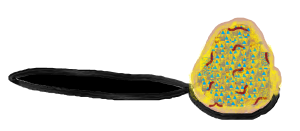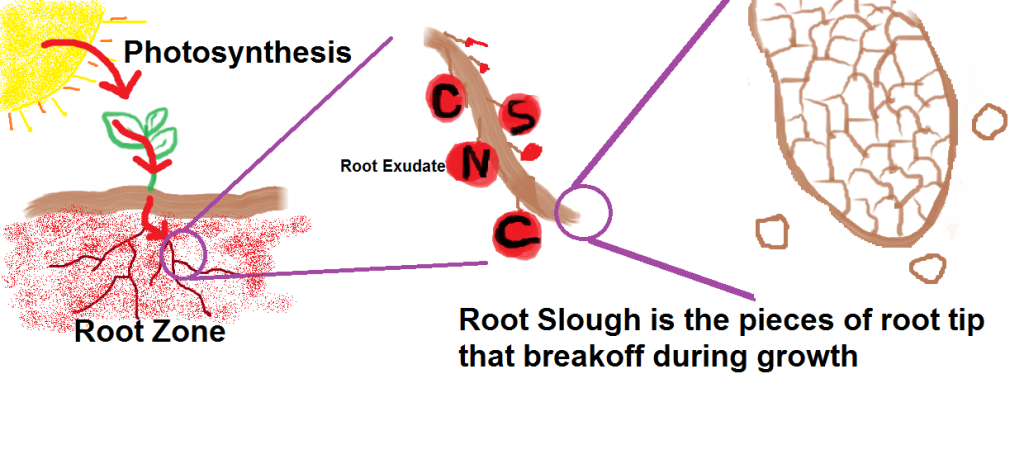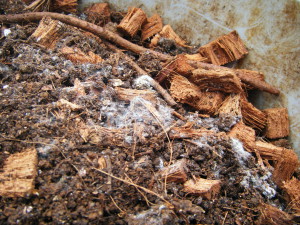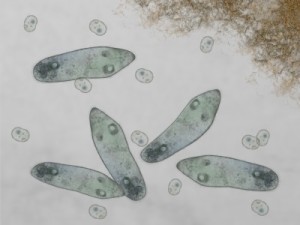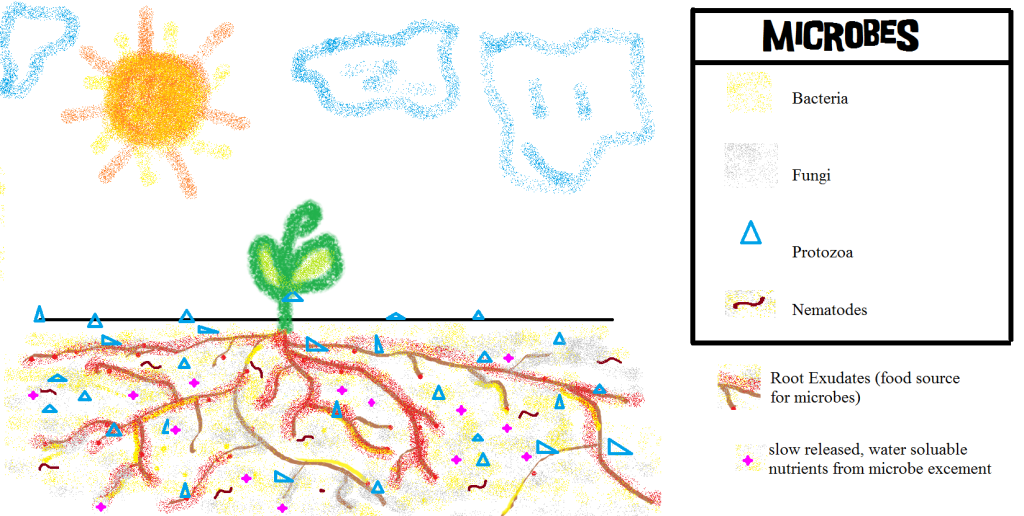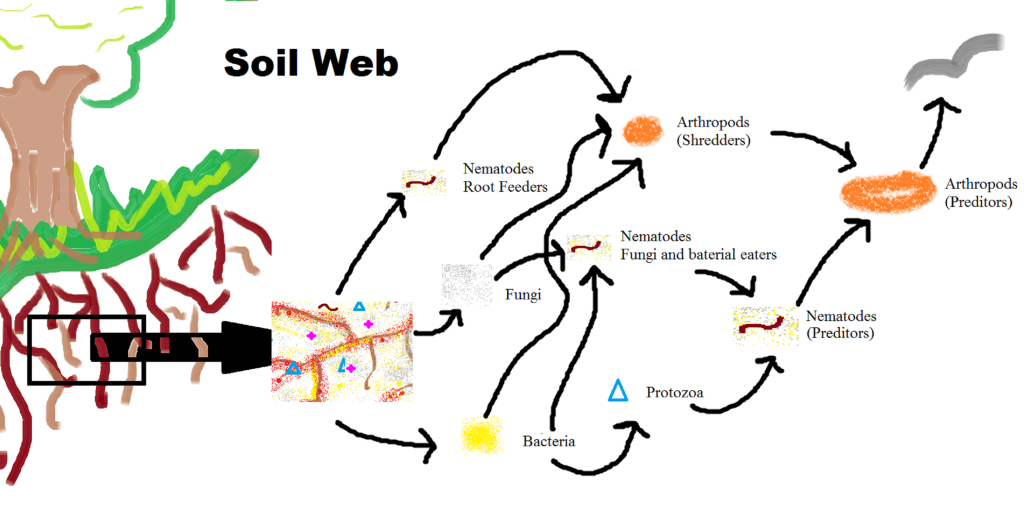Warning: Illegal string offset 'filter' in /var/www/wp-includes/taxonomy.php on line 1737
“No Spray”
“Microbes Are My Friend”
What are Soil Microbes?
Laura A. Rieber No Spray Staff Writer
What are microbes?
Microbes are the microscopic life forms that allow our reality to exist. We cannot see them, and as a society we have given little to no attention to them, let alone appreciation to their overall importance. Bacteria, fungi, protozoa, archaea, nematodes (microscopic round worms) and even some arthropods (jointed appendages) are considered microbes. Maybe you have heard of these before, or maybe not, either way they are very much a part of our daily lives and we should all know about them. Not to raise concern, but microbes are everywhere. There can be 250,000 in a space the size of a period. They cover our skin, our beds, our dishes and even inside our bodies. The following are the positives, the negatives and why microbes are my friends.
What do they do?
Microbes are tiny life forms that allow our lives to exist. In nature, they are responsible for the break down of organic matter. They act as glue, holding together soil and particles. They decompose a fallen tree in the forest and are responsible for what is happening in a compost pile. There are microbes that help our bodies consume and digest food. There can be over a trillion little microbes in your intestines alone. They also help break down the trash in the landfill, are responsible for breaking down animal poop in the yard, and even help in keeping you healthy.
What are microbes composed of?
In healthy soil, a mere teaspoon can contain billions of microbes. On average a teaspoon of healthy soil will have:
billions of bacteria
hundreds of thousands of fungi
2-3 thousand protozoa
40 to 50 nematodes
The more we understand about these soil dwellers the better gardeners, food growers and land owners we will become. The fact that microbes are so small and simple makes them easy to manipulate. When kept in balance, these tiny life forms do 75 % of the hard work for us, every moment of everyday. Now, don’t you want to grow food better than ever, spend less money, and do less work? It is possible: microbes are your friends! Learn why!
Bacteria:
Contrary to what most people think, not all bacteria are negative and you can not rid them from your presence (no matter how hard you try). There are more types of bacteria then there are people on Earth. They reproduce by single cell division, meaning they don’t have to go through the trouble of finding a mate, mating and “giving birth” to have an offspring. Instead they just “divide” themselves, continually, one after another, after another, after another until the source of food is depleated.
Reproduction of bacteria
It has been proven that in perfect conditions one single bacterium can produce over 4 billion offspring in less than 12 hours. These numbers are “lab” figures and in normal conditions bacteria are kept in check and balanced by “realistic” factors. These include, available food source, predators (and there are LOTS of things that eat bacteria) and the need for moisture. Healthy soil contains billions of bacteria in a mere teaspoon and through a check and balance system the bacteria ensure that no individual type will be able to “take over” the rest.
Slow Movers with Unique Abilities
Bacteria do not travel very far by themselves. They travel less than six micrometers within their entire life cycle. A micrometer is marking a meter into a million sections and only moving six marks. They will however “taxi” to another spot in the garden on a nematode or insect. Bacteria also have special abilities, one being that they can actually go dormant when harsh and unfavorable conditions are present. They just “curl” up into a protective barrier and wait until their favorite conditions come back. When conditions are favorable, bacteria in the soil become the primary decomposers of organic matter and are a major contributor to ALL “natural farming” methods and gardens.
The Good Ones, and the Bad Ones.
Bacteria in the soil must have a healthy balance to prevent one species from over-multiplying. There are typically two different types of bacteria, good and bad. In healthy soil, they keep each other in check. Good bacteria help plants obtain nutrients while bad bacteria cause harm to the plant in some way or another. Bacteria that are good for the soil can have their homes destroyed by tilling, spraying, the use of a tractor and the use of salt based fertilizers. When this happens, it creates a home for the bad ones. The bad bacteria then have an opportunity to multiply and out compete the good guys, creating soil that is unbalanced, unhealthy, and problematic, which then causes plant disease.
What do bacteria eat?
Soil bacteria feed off of several materials including the organic matter that is decomposing on the earths’ surface. The other primary food sources include root exudate and root slough. Root exudate are sugars, carbohydrates and proteins that the plant produces and excretes through their roots as a byproduct of gaining energy and nutrients through photosynthesis (the conversion of sunlight into useable energy). Root slough are the cells that come off during root tip growth. These two are actually from the plant roots which are located in the root zone.
How they stick around
Bacteria attach themselves to their food source by a very strong slime. While attached to their food source, bacteria receive their food directly through their cell walls. N (nitrogen), C (carbon), and S (sulfur) are some common nutrients that they consume. Once inside the bacteria cell, the nutrient becomes immobilized or locked up, preventing the loss of the nutrient from leaching, like during a heavy rain storm or even watering.
Mineralization, in simple terms
The nutrients remain locked up until the bacteria die or get eaten by another microbe. The nutrient is then released into the soil in a form that a plant can easily take up through their roots. This process is known as mineralization, a key concept in natural gardening systems which should be understood. In simple terms, mineralization is the means of obtaining nutrients in a form readily available for plants that was taken up as food and passed through another life form (microbe) and released when they die or are consumed.
The Perfect System
Nature has designed the perfect system starting with the bacteria. A plant gains energy from the sun, passes the excess out through the roots as exudates. This just happens to be the favorite food source of some sort of bacteria located nearby. The bacteria, consume it as its own nutrients and lock it up, preventing it from being washed away from the plant. When the bacteria die, the nutrient is left in a form available for the plant to take back up for its own use. An ingenious cycle!
Archaea
A Little About
Archaea are very similar to bacteria and hold very similar roles in the soil. They are important decomposers and oxidizers. They are a primary decomposer of organic material in unfavorable environments including hot springs, salt lakes, under miles of ice and in hot deserts. For agriculture purposes, archaea are one type of microbe that lives in the stomachs of cows and are responsible for the methane gas they produce. In short, they go where no others go, not even the bacteria! To the down and dirty! See, they are our friends.
Fungi
What are fungi?
Fungus, mushrooms, caps, mycelium, IMO’s, have you heard of them? Whether you have or haven’t, fungi are just as common as bacteria in our everyday lives and especially in our soils. Fungi in the soil and around our plants are commonly mis-perceived as being negative “visitors” and that the need to rid these somehow becomes priority. What most gardeners, home owners and farmers don’t realize is that fungi, for the most part is a saving grace when it comes to growing food. They do more for us then we give them credit for, and land owners rarely think twice about their well being.
There are numerous types of fungi in existence (over 100,000 that have currently been classified), including the popular “toadstool” (with the caps), the puffballs, the coral looking ones on trees and also the white “hair like” film that covers leaves when walking through the forest. These are all actually just the fruiting bodies of the mushroom. If you’re familiar with Korean Natural Farming methods, IMO’s (indigenous micro organisms) and the white mycelium, that is consistently being “fed,” is fungi.
Where Can you Find Fungi?
Fungi are also primary decomposers like bacterium and archaea. They are abundant in soils that are dominated by carbon (brown stuff, leaves, twigs, fallen trees, a wood pile etc.) but are also around in green matter and compost. If you check under the mulch in the garden, or under fallen leaves under the fruit tree, hopefully you will find white, thread-like hairs covering the underside. This is actually hundreds of thousands of single fungal hypae (individual fungi strands) that are joined together to form the network that we can see with a naked eye.
What do they do for the soil?
Fungi have similar roles in the soil as bacteria, but how they perform these roles are very different. Unlike bacteria who stay in a very tiny area, fungi grow in lengths that can be measured with a yardstick. Thanks to current technology we can now compare DNA from mushrooms and it has been found that the worlds largest living organism, a mushroom covering 2,200 acres, is in Oregon. That’s over three miles in length! Of course this is an exception, not all fungi grow the same.
Photo by: Laura A. Rieber
A special relationship
Some fungi called mycorrhizae, form special relationships with the plant roots that are around. They trade nutrients that they have obtained for plant exudates (the sugars, carbohydrates and proteins that the plant produces and excretes through their roots as a byproduct of photosynthesis (the conversion of sunlight into useable energy)). This is helpful in soils that have little to no organic matter. The fungi, with the ability to spread farther distances than the plant root can, are able to obtain nutrients from decaying organic matter far away from the plant root. They are then able to transport the nutrient through their internal interlocking web (imagine cotton being stretched out) and deliver it to the root tip. This creates a larger surface area from which the plant can obtain its nutrients. Every gardener loves hearing that!
Random Fact of Knowledge : Bacteria move, on average, only 6 micrometers over its entire life span, whereas, fungi can grow up to 40 micron meters in a minute!
How do they eat?
One of the most interesting aspects of fungi is how they “eat”. Fungi consume their “food”, their nutrients, through diffusion (osmosis) or active transport. The nutrients also become immobilized (like bacteria) within the entire mass of the fungus (no longer subject to leaching). Fungi will consume organic matter, protozoa and even nematodes. The nutrients are easily transported (yards away) through the haypae strands, something that bacteria cannot do. All the different branches that extend away from the fungi can actually collect and “trade” nutrients from different sources, all at the same time. Fungi: A great friend of any tree, making it a great friend to any farmer and land owner!
Protozoa
photo by: nixxphotography, FreeDigitalPhotos.net
What are Protozoans? Hopefully you remember these little life forms from high school biology class, looking at them through a microscope. The famous one, Paramecia, is the oblong rice looking thing with the hole on the bottom. They are the simplest “animals” and in the soil, are great recyclers of nutrients. Size-wise, if a bacteria was the size of a pea, a paramecium could be as large as a watermelon. There are over 60,000 kinds known and although they require moisture they live outside water and are found in the soil, helping to keep bacteria numbers in check.
What do they do?
Protozoa can be found where there is large amounts of bacteria compiling. In the soil, this means the rhizosphere (the root zone, where exudates are produced). Here they find billions of bacteria to feast on and mineralize into plant nutrients. An average protozoa can consume around 10,000 bacteria a day. Bacteria are substantially smaller in size than protozoans so are able to hide in pores and crevices in the soil too small for the protozoa to go. Also the slime they produce to attach themselves to things helps keep them protected from the protozoans. This helps keep the balance and inhibits the total annihilation of any bacteria source by protozoans.
Nematodes
What are nematodes?
Besides the well known parasitic nematodes that damage plant roots, little is known about the abundance of nematodes that reside in our soils and in our life. Nathon Cobb, who identified over 1000 different species of nematodes and is a well known scientist, wrote “If all the matter in the universe except nematodes were swept away, our world would still be dimly recognizable, and if, as disembodied spirits, we could then investigate it, we should find its mountains, hills, valleys, rivers, lakes, and oceans represented by a film of nematodes.” In another book, “The Earth Moved” by Amy Stewart, she sites a study about finding over 90,000 nematodes residing in one rotting apple. They can’t all be bad if they are everywhere, right!
Did you know?
In fact, nematodes are one of the most abundant animals on our planet, out numbered by only arthropods (insects, spiders, flies etc). They are roundworms with no segments making them different from the common earthworm and a lot smaller, yet considerably larger than protozoans. There are predatory and beneficial nematodes and in healthy soil there are more beneficial ones than predatory ones.
Good nematodes!
Good nematodes have several roles in the soil and help the gardener in many ways. Predatory nematodes are sold commercially for use on pests like the cutworm and slugs. Their size helps create tunnels throughout the soil allowing for easy passage of air and water. They also help “taxi” smaller microbes, like bacteria, to different spots in the soil. This can be a benefit, especially if you would like to spread nitrogen fixing bacteria throughout your bean sprout!
What do they eat?
Nematodes consume several types of food including bacteria, live plant matter (roots), protozoans, algae and even some small invertebrates and arthropods (slugs and grubs). They aid in mineralization and create a food source in and around the roots, for the plant to easily absorb. Needing less nitrogen to survive than protozoans, nematodes excrete more plant available nitrogen. This is a major positive for any natural gardener. In a healthy soil environment, nematodes are a benefit, and because we can’t live life without them, let’s work with them, and support microbial life to keep them checked and balanced.
Arthropods
What are arthropods?
Flies, beetles, crickets, cockroaches, ants, termites, creepy crawlies, bugs, critters are all examples of arthropods. There are a lot of them. Being the most abundant animal on the earth, they deserve a small section with the microbes. They are everywhere including in your compost, garden, lawn, carpet, skin, and even in your hair. These life forms in the soil are primarily shredders (chew up organic matter into smaller pieces allowing a spot for bacteria to attach and start decomposing it. As arthropods move around the soil they disperse other microbes to different areas, they also aid in mineralization and provide plant nutrients.
The role microbes play in the soil:
Untouched, microbes will work in harmony with plants. Plants get energy through photosynthesis where they convert the energy from the sun into usable plant energy. A portion of that energy is excreted out the roots as exudates. These exudates are very specific and attract specific bacteria, fungi, protozoa and nematodes in the area of the roots. Plants have the ability to manipulate their exudates that they excrete from their roots to suit their needs. The plant controls the population of these microbes by how much exudates they excrete. Regardless of the abundance of microbes in the soil, the plant, for the most part, is in control.
The bacteria and fungi that were attracted to these exudates will begin to multiply within the root zone, where there is now a food source. This spike in bacteria population attracts protozoa and nematodes in the area . As long as there is a healthy root stock, moisture and carbon (mulch, compost and organic matter) this natural balance will continue.
All nutrients that the bacteria and fungi consume becomes initially immobilized (locked up) preventing it from being leached with watering. The nutrients are then slowly released in a form that plants can easily take up and use. This is in the form of protozoa, fungi, nematode excrement and dead matter.
In the long run…
The soil under the surface is a living inhabited space of interactions, feeding and reproduction. Pathways and tunnels are created by microbes to and from food sources and living spaces. Imagine a bustling city full of life with good guys and bad guys. The good guys being the beneficial microbes, usually never seen nor appreciated, typically because they don’t cause problems. The bad guys are usually the first to be noticed even if there’s not too many of them, typically because they DO cause problems. If you spray toxic poisons on any part of the city, everything in that part of the city would die or mutate. The bad guys that might have been noticed will be destroyed, but so will all the unnoticed good guys.
The part that not too many people understand is that after the life is poisoned out, the condition of this city of tunnels and pathways is altered and is no longer favorable for the good guys. That place is not full of life nor energy. It’s not a happy place to be anymore. But the bad guys like it. So they find themselves a nice home to multiply unchecked for a while. If balance is not sought, they can spread and deteriorate the life of surrounding soils. In most cases, the good guys can outnumber, over-rule, and control the bad guys. But only if not poisoned and given the appropriate tools such as compost and mulch to help them do their jobs correctly and all naturally.
Authors Notes:
This is a general overview of microbes to, hopefully, give an idea of just how many life forms with which we are living. We can not control their population, yet we can work to promote the abundance of the positive ones. Learning to work with these guys to your benefit can make or break a natural gardener or farmer. I encourage you to question what you read, find other sources that say the same or different things. Check where they are getting their information from and what they are trying to sell. See who wrote the book, take the time to read about the author and what their interests are. This is your soil, your plants, and your life you’re learning about.
The Food Web
The soil and all the life forms that it holds is a mere web of food sources. Keeping natural checks and balances. The soil web is different then the food chain with which we are familiarize.
How Humans disturb:
Spraying
Tilling
Tractor (compacting)
Monoculture
Use of inorganic fertilizers
============================================================
About the Author:
 Laura Rieber holds a BS in Agriculture with a focus on sustainability from the University of Hawaii, several certificates in agriculture business development and is a master gardener. The moment she realized the corporate lies that feed the world was the moment she was inspired to write about the truth about natural agriculture. She co-created No Spray Hawaii with her partner, Jesse Fujimoto to help others gain awareness. She teaches natural agriculture principles on the Big Island of Hawaii. CONTACT
Laura Rieber holds a BS in Agriculture with a focus on sustainability from the University of Hawaii, several certificates in agriculture business development and is a master gardener. The moment she realized the corporate lies that feed the world was the moment she was inspired to write about the truth about natural agriculture. She co-created No Spray Hawaii with her partner, Jesse Fujimoto to help others gain awareness. She teaches natural agriculture principles on the Big Island of Hawaii. CONTACT
==========================================================
Edited by: Monique Moreno and Darlene Rieber
References and GREAT books / articles to read:
Denice de Oliveira Almeida, Osmar Klauberg Filho, Henrique Cesar Almeida, Luciano, Gebler, Aline Franciane, Felipe. 2010 “Soil microbial biomass under mulch types in an integrated apple orchard from Southern Brazil”. Sci. Agric. (Piracicaba, Braz.), v.68, n.2, p.217-222, March/April 2011
Herms, Daniel A, Lloyd John E, and Stinner, Benjamin R. 1999. “Effects of Organic Mulches and Fertilization on Soil Microbial Activity, Nutrient Availability, and Growth of River Birch”. Department of Entomology, The Ohio State University, Ohio Agricultural Research and Development Center. Wooster, Ohio
Hoorman, James J, and Islam, Rafiq. 2010. “Understanding Soil Microbes and Nutrient Recyling”. Ohio State University, Extension
Jean M. A., Marshall Bradley, Nick & Fern, 1994. “Growing Fruits and Vegetables Organically”. Rodale Press
Gladstone, Nancy. 1997. “Action Sheet 34: Mulching, So what is mulching?” Outreach TVE Soils Education Pack:Soil Improvement in the Tropics article on Mulching.
Lownfels, Jeff & Lewis, Wayne. 2010. “Teaming with Microbes, The Organic Gardener’s Guide to the Soil Food Web”. Timber Press: Portland, Oregon.
Stewart Amy, 2004. “The Earth Moved, On the Remarkable Achievements of Earthworms”. Algonquin Books of Chapel Hill: North Carolina.
“No Spray”
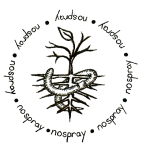
~find another way~

